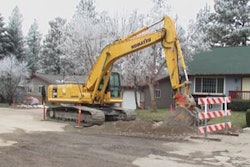Construction activity over the past year has shown persistent strength, despite record high fuel and material costs. Given industry forecasts, there’s no reason to expect 2006 to be much different.
“It’s going to be a good market,” predicts Ed Sullivan, chief economist for the Portland Cement Association. “It will probably be a little less strong than I had originally thought because of Hurricane Katrina and its effects, but we’re still looking at a good year.”
The 30th Annual CIT Construction Industry Forecast indicates U.S. construction industry leaders also anticipates another strong year ahead, with some reservations. “While their optimism is more cautious than the previous year, their positive predictions for 2006 — in terms of equipment rentals and purchases, net income, business strategies, technology and issues and opportunities — give hope for what’s to come,” states Ron Riecks, executive vice president of CIT Construction.
Most economists are forecasting a significant increase in commercial and public construction, with a slight slowdown in residential activity. Areas showing the greatest growth potential include the manufacturing and hospitality segments.
In the highway and road sector, the combination of renewed economic activity, emergency repair work following the hurricanes in the Gulf Coast and enactment of SAFETEA-LU should help highway construction grow by 5.4%, notes William Buechner, vice president of economics and research for the American Road & Transportation Builders Association. The value of construction work performed on highway and bridge projects is projected to be a record $70.3 billion, up from $46.9 billion in FY 2005.
And while residential construction is expected to decline, the drop should be minimal. According to the National Association of Home Builders, housing starts are expected to fall from an estimated 2.05 million in 2005 to 1.94 million in 2006 and 1.88 million in 2007. Yet, these numbers are still higher than every year excluding 2004.
Of course, the wild card for 2006 continues to be the costs of fuel and materials.
“The cost of running equipment and transportation costs will continue to rise with diesel prices,” states Ken Simonson, chief economist for the Associated General Contractors of America. “People have a misconception that the oil crisis is over. Prices have dropped sharply, but they are still higher than a year ago.”
Another misconception surrounds the rebuilding of New Orleans and other Gulf Coast areas. This has been perceived as a potential construction boon for 2006, yet its impact may still be months away. “From everything I hear, it’s going to be a very long process,” says Simonson. “There is a lot of cleanup needed before rebuilding can begin, so we are looking at the second half of 2006 at the earliest.”
In the meantime, the storms’ effects could continue to negatively impact construction via decreased activity in affected areas, as well as higher material prices.
Yet despite such uncertainties, they have done little to dampen economists’ enthusiasm for further growth in construction activity in 2006. This bodes well for continued profits for most of your pocketbooks throughout the months ahead. ¦
















